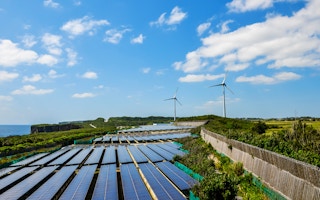A new clean technology to turn sunlight into liquid fuel could drastically shrink the need for large plantations to grow crops for biofuels, while combating climate change, Harvard University researchers said on Thursday.
That could help protect food supplies and local people’s land rights, they suggested.
Dubbed “bionic leaf 2.0”, the technology uses solar panels to split water molecules into oxygen and hydrogen, the scientists said in a study published in the journal Science.
Once separated, hydrogen is moved into a chamber where it is consumed by bacteria, and with help from a special metal catalyst and carbon dioxide, the process generates liquid fuel.
The method is an artificial version of the photosynthesis process plants use to make energy from sunlight, water and carbon dioxide, scientists said.
If it becomes economically viable, the technology could replace oil wells or plantations where food crops are grown for fuel, the study’s lead author said.
“This (new energy source) is not competing with food for agricultural land,” Harvard University Professor of Energy Daniel Nocera told the Thomson Reuters Foundation.
Crops such as corn and sugar cane have been increasingly cultivated to produce biofuels. About 4 per cent of the world’s farmland is used to grow crops for fuel rather than food, according to a University of Virginia study published in March.
Tens of thousands of small-scale farmers across Africa, Asia and Latin America have been displaced by plantations growing crops to make biofuels, according to GRAIN, a Barcelona-based land rights group.
“
“Bionic leaf 2.0” converts solar energy into liquid fuel with 10 per cent efficiency, far higher than the 1 per cent efficiency seen in the fastest-growing plants that use a similar process.
Daniel Nocera, professor of Energy, Harvard University
The new technology could help protect their land rights while also reducing the greenhouse gas emissions that are warming the planet, Nocera said.
“The (land) footprint these solar panels need is about one tenth the size of what you would need for sugar cane,” he said.
If governments put a price on carbon dioxide emissions, the “bionic leaf” would appeal to investors as a cost-effective alternative energy source, the professor added.
Today, however, it remains cheaper to grow biofuel crops or extract fossil fuels than to produce renewable energy, Nocera said.
A carbon tax boosting U.S. gas prices to European levels - although not yet on the cards - would likely be enough to spur investment in the new technology, he said.
“Bionic leaf 2.0” converts solar energy into liquid fuel with 10 per cent efficiency, far higher than the 1 per cent efficiency seen in the fastest-growing plants that use a similar process, Nocera added.
This story is published with permission from the Thomson Reuters Foundation, the charitable arm of Thomson Reuters, that covers humanitarian news, women’s rights, trafficking and climate change. Visit news.trust.org.










